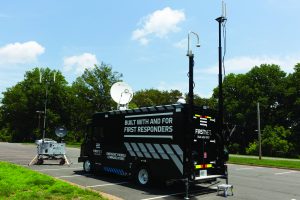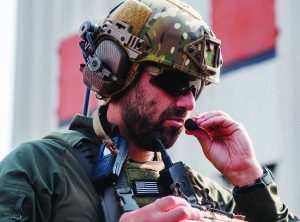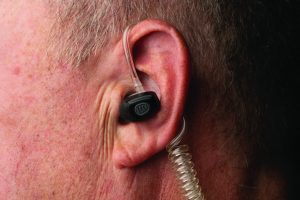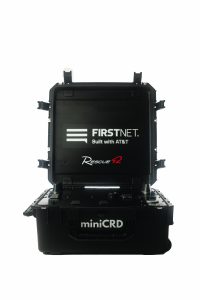“911—what’s your emergency?” One of the most recognizable questions has become a lifeline for countless individuals. From the first frantic call of a witness to the calm, reassuring voice of the dispatcher, one question can be a sign that help is on the way.

The coordination between witness, dispatcher, and officer would not be possible, though, without an effective communication device. From the 911 infrastructure to police radios to internal communications, these tools are indispensable in ensuring public safety and enhancing officer efficiency.
The 911 Cycle
The first step to almost every emergency response is a witness’s call to a public safety answering point (PSAP). “In many ways, the 911 system functions as the eyes and ears of police departments,” said Jason Lackey, Intrado’s director of product marketing.1 With over 45 years of experience in building 911 systems, the largest E911 footprint in the United States, and more than 6,000 primary and secondary PSAP connections, Intrado is very familiar with the end-to-end needs of telecommunicators. For many years, the flagship call-handling solution, VIPER, was used to effectively and rapidly respond to every call. Now, VIPER is available as a Cal OES-certified hybrid cloud service, which will enable faster and easier access to the well-known platform.
VIPER as a Service (VaaS) includes powerful artificial intelligence (AI) extensions that will empower a PSAP. Intrado Voice-to-Text allows operators to rapidly connect people with the help they need through translation and language detection tools. Intrado is also future-proofing PSAPs by improving their Text-2-911 feature. As there are situational and sociological reasons that are driving this texting service, Intrado has made real-time language detection and translation also possible for Text-2-911 communications.2
“With [AI] enhancements, VaaS goes beyond just making call handling easier for the PSAP,” said Lackey. “It helps enable a better, more efficient and complete [quality assurance] process with 100 percent call coverage.” The quality assurance enhancements have aided hiring, retention, and training challenges of PSAPs. Command Center AI allows visibility into all calls, which has been known to improve morale and decrease call handling times.
Once a call is taken, the information will be passed along to the appropriate emergency services. Motorola Solutions builds mission-critical technologies to facilitate collaboration between dispatchers and public safety providers to simplify workflows and help officers make informed decisions for efficient and effective incident responses.
“We looked at how agencies could save time and show up to a scene more informed if a first responder didn’t need to ask a dispatcher to repeat their transmission or go back to their car to check an incident detail,” explained Colonel James M. Wolfinbarger, director of the Public Safety Industry Team at Motorola Solutions and retired chief of the Colorado State Patrol.3 The company found a solution in a tool that is already equipped on their duty belt: a radio.
Motorola Solutions’ SmartIncident is a computer-aided dispatch client that helps bridge the information gap between dispatchers and first responders by pushing critical information right to an officer’s smart radio. From a PSAP, dispatchers can push vital information that a 911 caller provides to responders’ radios, including messages, pictures, and video and audio clips. From the field, officers can check who is assigned to an incident, notify dispatch of their status, and see dispatcher warnings of known hazards on the touchscreen of their radio. By changing the way dispatchers and first responders communicate, SmartIncident frees up radio channels for mission-critical verbal updates.
The broadband–enabled application is available on Motorola Solutions’ APX NEXT and APX N70 products.

When the response to a 911 call escalates or requires a team, the team requires proper headsets for immediate internal communications. Crowd control and bystander safety, as well as coordinating medical care for injured victims and responding to threats, all amplify the need to communicate quickly and clearly.
Since 1961, OTTO Engineering, Inc. (OTTO) has continued to design, test, and manufacture high-quality, durable, and reliable products to ensure precision in mission-critical environments. “As part of OTTO’s evolution of products, we developed a line of hearing protection headsets and earpieces utilized in range training and tactical communications,” said Steven Du Charme, marketing assistant at OTTO.4
OTTO’s NoizeBarrier technology (available in the NoizeBarrier Range SA, NoizeBarrier TAC, and NoizeBarrier Micro) provides 360-degree advanced situational awareness microphones that amplify local conversations and enhance sound localization. The technology not only dampens loud blasts, wind, and background noise but also delivers unparalleled sound reproduction. It also eliminates what is known as clipping—the temporary erratic audio dropouts that cripple clear communication. As a result, users experience transmissions that can be easily understood, even in a disruptive and loud environment.

While the NoizeBarrier product line provides a significant tactical advantage in mission-critical situations, it also protects the hearing health of officers. “Permanent hearing loss can be caused by many factors,” explained Du Charme. “One of the most common is repeated exposure to loud, impulse, or continuous noise exceeding safe thresholds.” NoizeBarrier Range SA and NoizeBarrier TAC provide a noise reduction rating of 23 decibels and the NoizeBarrier Micro provides a rating of 28 decibels.
Making a Connection
Communication without connectivity is nearly impossible. But often, it is necessary for officers to respond to calls located in congested—or remote—areas. It is imperative that agencies equip their staff with solutions to help first responders stay connected.
Shaped by the vision of U.S. Congress and the first responder community following the 9/11 terrorist attacks, FirstNet is built with AT&T in public-private partnership with the First Responder Network Authority, which is an independent agency of the federal government. In their miniCRD and MegaRange offerings, FirstNet is bringing a level of interoperable connectivity and advanced capability that helps transform the role communications play in U.S. public safety responses.

The miniCRD came from the need to make the popular compact rapidly deployable and even smaller and more portable during emergencies. The deployable kit is contained in two rugged cases labeled miniCRD and SLC+, each having different functions. The miniCRD case creates a FirstNet Band 14 Cellular and Wi-Fi hotspot; the SLC+ case contains the high-performance satellite system that provides cellular backhaul and high-speed internet almost anywhere. The kit can be transported by a single person in a vehicle, by air, or over water to wherever communications are needed. Within a matter of minutes, the miniCRD can extend the FirstNet network up to a half mile. This advanced technology acts as a solution for challenges officers face when trying to stay connected during emergencies, in rural locations, or during large events where networks can get overwhelmed.
The miniCRD is compatible with FirstNet’s MegaRange HPUE for up to one mile. MegaRange is used to improve connectivity and uplink data speeds to keep first responders communicating in areas that are unreachable with standard powered devices. Offered in three versions, these specialized devices are six times the power of traditional routers. Nextivity Shield MegaFi (Mobile) is for use in vehicles, Nextivity Shield MegaFi (Fixed) is for use in buildings like a command center or PSAP, and the Nextivity Shield MegaGo is a portable solution.5
Conclusion
Although 911 is not the emergency response number for every country, the process remains the same. A witness makes a call to emergency services. The dispatcher taking the call informs the appropriate service needed (police, fire, or emergency medical services). And a response is made.
None of this would be possible without the use of proper communication tools.d
Notes:
1Jason Lackey (director of product marketing, Intrado), email interview, October 3, 2024.
3James M. Wolfbarger (director of the public safety industry team, Motorola Solutions), email interview, October 11, 2024.
4Steven Du Charme (marketing assistant, OTTO Engineering, Inc.), email interview, October 14, 2024.
5FirstNet Product Team (FirstNet, Built with AT&T), email interview, October 5, 2024.
Source ListPlease click on the companies’ names to go to the companies’ websites. |
|
Please cite as
“The Call for Help,” Product Feature, Police Chief 91, no. 11 (November 2024): 58–60.


